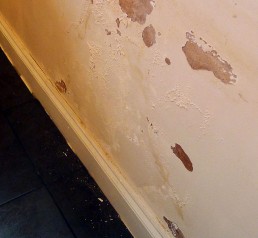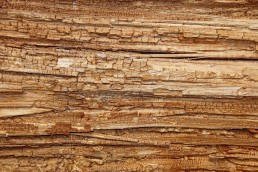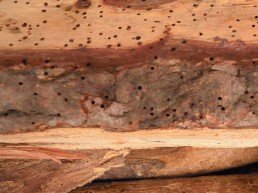How Do You Stop Damp Coming Through Walls?
Damp, moisture and water can all cause unwanted or even dangerous damage to a home when they start penetrating the walls.
Damp damage can lead to mould, wood rot and even the collapse of structural supports within a home or commercial property, so it’s important that your home is kept damp free and damp proof.
In this article, we take a look at the best ways to damp proof your property.
Does Your Property Have a Damp Proof Course (DPC)?
A damp proof course (DPC) is the most effective barrier against rising damp, a form of damp that occurs when water from the outside seeps upwards into the walls of your home.
It’s a protective, waterproof layer that stops damp from rising. Damp proof courses can vary but often consist of a simple plastic layer or a more effective chemical membrane.
Modern homes are required to have a damp proof course, however many older properties might never have had one installed. Damp proof courses can also break or degrade over time, leaving your building defenceless against rising damp.
To protect against damp, you need a DPC and you need it to be working. Luckily, they can be repaired or installed by a professional.
Are There Any Water Leaks?
Leaking water is one of the biggest causes of damp, and it’s often due to faulty or overloaded infrastructure.
Bad plumbing or leaking pipes can quickly lead to dampness in the walls, while blocked drains and gutters can cause water to flood through the roof or external walls.
Check your plumbing is up to scratch and that your pipes aren’t blocked, and you’ll prevent damp from getting into the walls.
Is Your Property Ventilated?
Damp doesn’t just get into a home from the outside; it can also be caused by internal problems. The biggest culprit is often a lack of ventilation.
Poor ventilation causes a build-up of condensation (particularly in areas where hot and cold air meet, such as the kitchen or bathroom). This leads to damp getting into the internal walls of a property, which can then lead to mould or wood rot.
If you’re struggling with condensation, then a simple solution is a dehumidifier. Often, it’s enough just to leave the windows open for longer, too!
Have a Damp Survey Carried Out
It can be difficult isolating the cause of damp in a building, particularly if there’s a problem with the structure or damp proof course.
For this reason, it’s recommended to have a professional damp survey carried out by a specialist. As well as identifying existing problems, they can also provide recommendations for damp proofing the property. After all, preventing damp problems from arising is always preferable to carrying out expensive repairs.
Contact Damp Proofing Specialists in Yorkshire and Teesside
For more information and advice on damp proofing your home or commercial property, then please contact our friendly team on 01765 804050 or fill in our online contact form. Our experienced specialists will be on hand and ready to offer expert advice tailored to resolve your problem.
How to Treat Wood Rot
Wood rot is caused by fungal spores eating their way through wooden timbers, be it wooden furniture, door frames, or even the structural supports holding a building together.
As timbers decay they become increasingly unstable and dangerous, leaving a major health and safety hazard inside your home or commercial property.
So how do you treat wood rot and prevent it from returning? In this article, we explore the best ways to treat wood rot.
What are the different types of wood rot?
There are two distinct types of wood rot that need to be considered before any treatments can be recommended and applied. These are wet rot and dry rot.
Both types of wood rot are caused by fungal spores eating through cellulose found in timbers. Both only occur in wet and damp conditions, as the fungal spores are activated by moisture.
Wet rot requires extremely high levels of moisture to survive, so it’s only found in incredibly damp conditions. Wet rot mostly remains static, but causes large amounts of damage when left untreated.
Dry rot requires much lower moisture levels to thrive, so it can easily spread through a home from one timber to the next. Dry rot can quickly cause damage as it spreads, and needs to be treated rapidly.
What are the signs of Wood Rot?
While wood rot might not be visible on the surface, it could be causing massive amounts of structural decay beneath the timbers.
For this reason, it’s important to be given a proper diagnosis by a professional who can locate and identify different types of wood rot that could be afflicting your home, before recommending the best course of treatment.
If you notice any of the following signs of wood rot, it’s time to call in a specialist.
● Musty or mushroom-like smells
● Growth of mould
● Soft timbers
● Discolouration of timbers
● Visible decay of timbers
● Areas of damp
How to identify and treat wood rot?
The exact treatment depends on the extent of the wood rot, how long it has been spreading for, and the damage that’s already been caused.
The first step is to identify where the rot has taken hold and the type of rot that’s present in the property. While dry rot can be very visible, wet rot is often hidden out of sight.
The most effective method of wood rot treatment is to apply a fungicide or chemical spray. This kills any existing spores and creates a protective anti-fungal layer that stops future fungal spores from establishing themselves on timbers. This only works however if the rot is on the surface.
If the wood rot is below the surface or has already caused extensive damage to important, structural timbers, then the only treatment is to remove the timbers and replace them. This is much costlier and more disruptive, which is why it’s so important to act fast when you suspect the presence of wood rot in your property.
Get in touch with Wood Rot Treatment Specialists
For more information and advice on how to treat wood rot – both wet and dry rot – then please contact our friendly team on 01765 804050 or fill in our online contact form. Our experienced professionals will be ready to offer expert advice tailored to resolve your problem.
What Are Cavity Wall Ties Used For?
Cavity wall ties are the unseen supports holding the walls of a building together. They are an essential yet invisible element of building construction, providing stability and ensuring that walls don’t collapse.
Despite their importance, cavity wall ties are rarely top of maintenance lists for homeowners; most of us don’t even realise they’re there! In this article, we explain what cavity wall ties are and what they are used for.
What are Cavity Wall Ties?
Cavity wall ties are metal strips or metal rods used to connect walls together, providing structural support to walls and to a building as a whole.
Cavity wall ties are placed between the inner and outer walls of a home (the space in between the two layers is called the cavity, and it’s there primarily for insulation). These thin metal rods connect the two layers together, essentially holding them up.
Given how important this sounds, you might be surprised to see just how thin cavity wall ties are. However they’re produced from incredibly strong metal alloys, with steel or zinc being the most common.
Why are Cavity Wall Ties so Important?
It’s always necessary for broken or damaged cavity wall ties to be replaced, because the role they provide is vital to a building.
Cavity wall ties hold the bricks of the two layers of a wall together, allowing the wall to stand as one firm unit rather than two individual sections. This provides an excellent level of structural support for a property as a whole, and stops structural instability or collapses from occurring.
Cavity wall ties also enable better insulation, allowing a building to be managed in an energy-efficient manner. They help to maintain proper ventilation by keeping the cavity wall space supported, which helps to avoid a build-up of moisture or damp between the walls.
What is Cavity Wall Tie Failure?
Homeowners need to look out for broken or damaged cavity wall ties that are the result of cavity wall tie failure.
Cavity wall tie failure can result in broken masonry, loose tiles and, in extreme cases, total collapse of walls. If broken wall ties aren’t replaced, the consequences can even be deadly.
While cavity wall tie failure can be the result of improper installation or poor brickwork, in the vast majority of cases failure is down to corrosion and rusting. Cavity wall ties are metal and therefore prone to corrosion when subjected to water.
This is a natural process. Regardless how well your home is damp-proofed, it can’t be stopped entirely; it can only be delayed. For this reason, it’s good to know what signs might indicate that cavity wall ties need replacing.
If you notice any of the following, contact a professional for a survey. They can identify the extent of the wall tie failures and recommend solutions for replacements.
● Cracks in the mortar caused by an expansion of cavity wall ties.
● Walls bulging outwards as a result of broken cavity wall ties.
Loose brickwork or, in severe cases, a collapse.
Danford Brewer & Ives is a Ripon based company that operates in the North East and specialises in cavity wall tie replacement. For more information and advice on cavity wall ties, please contact our friendly team on 01765 804050 or fill in our online contact form. Our experienced professionals will be on hand and ready to offer expert advice tailored to resolve your problem.
What Is Water Ingress?
Water ingress is never good news for any homeowner, and it needs to be dealt with quickly to avoid expensive repairs in the future.
What Does the Term Water Ingress Mean?
Water ingress is the term used to describe any unwanted water that comes into a building.
When water enters a building from aboveground sources it is often called ‘penetrating damp’. It can occur anywhere within the property, including the roof.
‘Rising damp’ is the term used to describe water ingress that enters a building from ground level and travels upwards into the building, through porous building materials. Cellars and basements are key target areas.
What Can Cause Water Ingress?
The most common reasons for water ingress are building faults and defects. These can be due to the normal deterioration of building materials over time and the effects of the weather. Unfortunately, poor workmanship can also be a cause.
There are several ways that water ingress can occur:
- Faulty plumbing – burst or slow leaking pipes
- Windows – faulty flashing around the window frames
- Roofs and chimneys – damaged or missing roof tiles or slates, or damaged flat roof protection, damaged flashing
- Blocked or faulty gutters and downpipes
- Walls – cracks in the render, damaged or missing mortar, blocked air bricks, damaged external pipework
- Faulty or damaged damp proof course, no damp proof course (common in older buildings).
- Flooding – there is a higher risk if you live in a flood plain
What Damage Can It Do?
Timber damage
Damp timbers can attract the fungi, which could lead to dry or wet rot if left untreated. These can be expensive to treat as well as causing structural damage.
Higher humidity levels can also increase the risk of attracting the beetles that cause woodworm infestations.
Masonry damage
Any cracks in the bricks, render, or mortar can let water in. This is made worse in freezing conditions.
Internal walls
Damp internal walls can cause mould and damage to plaster and paint.
Health
Damp and moulds are known to affect health by producing allergens, irritants, and toxins. The very young, old, those with poor immunity, existing respiratory and/or skin conditions are most at risk.
How Do I Know If I Have Water Ingress?
Building materials are porous making it easy for water to spread in the same expansive way that kitchen roll absorbs water.
The main warning signs that you should look for are:
- Damp patches on internal walls
- Damp patches on floors, especially in basements and cellars
- Damp patches on external walls
- Mould growth on walls and floors
- Peeling paintwork and/or plasterwork
- Hearing dripping sounds
- Damp and musty smells
What Should I Do If I Think I Have Water Ingress?
The first step in dealing with water ingress is to prevent any further damage, such as using a bucket to catch drips.
The next step is to find the source of the water ingress. This may be difficult due to water absorption patterns or difficult-to-access places. You may be able to fix the problem yourself.
The treatment you need will depend on the source of the water ingress and any subsequent damage. There are several different treatments available and a damp proofing specialist will be able to advise you on the options.
How Can I Prevent Water Ingress?
The best ways to prevent water ingress in your property are:
- Regular checks inside and outside the property for any signs of damage.
- Check the render, mortar, and pointing for any damage, as they can often be damaged by bad weather.
- Keep gutters, downpipes and drains clear from debris such as leaves.
- Repair any damage as soon as possible, such as bathroom grouting.
- Check your roof, chimney and window flashings for damage, especially after bad weather.
- Keep your property well ventilated by opening windows or using positive air ventilation, and heating systems. These measures prevent an internal build-up of moisture.
- Early intervention will reduce the risk of serious and expensive damage.
When Should I Contact a Damp Proofing and Timber Preservation Specialist?
There are no hard and fast rules on when you should seek specialist help for damp-related problems.
The guidance is that if you have a persistent problem with slow-moving condensation, signs of wood rot, or evidence of damp or mould on your ceilings, walls or floors, then you should call a damp proofing and timber preservation specialist such as here at Danford Brewer and Ives.
By getting professional advice and early intervention you should be able to avoid expensive damage and repair works.
Open As Usual
Tuesday, 03 November 2020.
We are still open! ?♂️
Following Prime Minister Johnson’s announcement on Saturday, we would like to inform you that as we are part of the construction industry we are expected to remain open throughout the next lockdown, allowing us to continue to carry out surveys and works within people's homes.
Danford Brewer & Ives are continuing to operate as normal with all safety precautions in place. We have a COVID policy in place to ensure the safety of our customers and employees whilst a survey/any works are being carried out.
If you wish to arrange a damp, timber or basement survey please do contact us on 01765 609990 or visit our website www.dbi-ltd.com!
We can take and discuss any enquiries and are looking to book in surveys, carry out works and site visits whenever and wherever it is safe to do so.
Thank you to all our customers for your support during these uncertain times!
David Ingham

Why Do I Need a Damp and Timber Report?
Damp and timber reports are an essential feature of homebuyers surveys, offering you peace of mind before purchasing your dream home or alerting you to the presence of dangerous damp, mould or woodworm before you sign the contract.
Damp and timber reports have a wide range of benefits, and they’re well worth the extra cost. To help you to better visualise why a damp and timber survey is so important, we asked our experts at Danford Brewer & Ives to explain more about why you need these reports.
What Is a Damp and Timber Report?
Damp and timber reports, also known as a damp and timber survey, are the only way to confidently know if your home is free from damp, mould and woodworm.
They provide you, as a potential homeowner, with a detailed analysis of damp that may be present in a building, including damp and condensation. A damp and timber survey can also catch signs of woodworm infestations and any other types of mould or timber decay that may be present.
As a minimum, it will identify if any of the following are present:
-
Condensation damp
-
Rising damp
-
Penetrating damp
-
Wet rot
-
Dry rot
-
Woodworm infestations
-
Other pests
Many of the problems associated with damp or woodworm infestations are difficult to identify without specialist knowledge and experience. Many infestations and types of damp look remarkably similar, and while some are potentially damaging to the structure of a property, others can be harmless.
A damp and timber survey is carried out by a professional, qualified surveyor who examines all areas of a property where damp could be present. This includes the outside and inside of the home, under the floorboards, in the attic and in the walls. A professional surveyor not only identifies existing problems but can provide details and expertise on potential solutions too.
What Are the Benefits of Damp and Timber Reports?
There are multiple reasons to have a damp and timber report carried out before you purchase a property. They are commonly organised by homeowners who believe they have an existing damp or timber problem, which they are struggling to identify themselves.
Damp and timber reports provide a thorough examination of the safety of a building’s structure, including integral areas such as the foundations. Mould and damp can also cause long-term health problems and respiratory illnesses, so for health and safety alongside peace of mind, a damp and timber survey is incredibly important.
For homebuyers, having existing problems identified gives them the opportunity to negotiate prices or have the current owner fix those problems before purchase. Structural problems are expensive to fix, so a damp and timber survey could save you thousands of pounds, making it well worth the initial upfront costs of organising a professional report.
Damp and timber reports have a number of benefits that make them an essential part of pre-purchase home surveys:
-
Identify dangerous or costly damp and timber problems
-
Identify problem areas below ground level, which might not be evident without a professional
-
Identify areas of the home that may become a problem in the future, if not well maintained
-
Avoid the need for expensive damp proofing after purchase
-
Avoid the need for expensive post-purchase woodworm treatments
-
Prepare the home for condensation or damp in winter
-
Identify the source of musty smells
-
Create a healthier home environment
Contact Danford Brewer & Ives today
Danford Brewer & Ives has been providing damp and timber reports for decades to homeowners in Yorkshire, Teesside and North East England. We’re happy to discuss the benefits of a damp and timber survey with you in more detail.
Please contact our friendly team on 01765 804050 or fill in our online contact form. Our technical team will be on hand with expert advice tailored to resolve your problem.
How to Keep Condensation and Damp Out This Winter
With winter fast approaching, it’s time to start shoring up your defences against the oncoming tide of condensation and damp, which can severely affect homes during the colder months of the year.
Condensation is the most common problem for homeowners in winter, with poor ventilation leading to lots of potential for hot and cold air to collide. While condensation is easily avoided, if it’s left for too long it can start to cause mould or even damage to walls and ceilings.
Condensation is a mild form of damp, but homeowners also need to be on the lookout for more serious damp problems during winter. Rising damp and penetrating damp are much more serious issues, leading to mould and potential structural problems.
It’s important to know the difference between damp and condensation and to know how to keep condensation and damp out of your home during winter.
Condensation During Winter
Condensation is the most common form of damp, and during winter it can be a real pain for homeowners. Thankfully, it’s usually more annoying than it is dangerous, and there are plenty of quick fixes to keep your home condensation-free during winter.
Condensation happens when hot, moisture-heavy air collides with colder, drier air. As the air mixes, condensation (water droplets) forms on windows, doors, and ceilings.
If you’re having a hot shower in winter, your windows and mirrors will steam up as condensation forms. In the kitchen, switch on the kettle or start simmering a hearty winter soup and you have the same problem.
Condensation forms on colder surfaces, which are more prevalent in winter than in summer. The problem is exacerbated by the fact that we keep our doors and windows closed during winter, to keep in the heat and to keep out the cold.
Poor ventilation is the biggest cause of condensation in winter, but also the easiest fix: just open the window. However, condensation can form in less obvious places, where it can become more of an issue. Check out this article on how to treat condensation in your homes.
Condensation often forms on the ceiling and can get into the attic during winter. This is when it could start to cause damage to your painting and plastering or, if left long enough, to the structure itself. As a form of damp, excessive levels of condensation lead to mould, which can cause respiratory problems. In the depths of winter, respiratory illness is the last thing you need.
Damp During Winter
While condensation is a form of damp, there are more serious types of damp that you need to be aware of. Damp can occur at any time of the year, but in winter the problems are worsened by colder weather and lack of ventilation.
Rising damp occurs when moisture starts moving up from the ground and into the structure of your home. It’s common in older houses, but rare in newer homes that have been adequately damp-proofed.
Penetrating damp is more common, and occurs when water starts moving down or horizontally through structures. It’s often the result of cracks in the walls, loose tiles and leaks. Due to temperature differences and bad weather, cracks and leaks are more common in winter than other times of the year. If you own a listed building, then check out this article on how to treat damp in listed buildings.
Both rising and penetrating damp can lead to mould as well as structural problems, so it’s crucial that you lookout for early signs (and musty smells). If you think you have a rising or penetrating damp problem during winter, contact the professionals immediately.
Tips to Reduce Condensation and Damp
While condensation and damp can be serious, in most cases there are a few simple fixes that can help you to avoid any serious problems.
Here are our best tips to help you avoid condensation and damp this winter.
- Open the Windows
Our biggest tip isn’t exactly a secret: open your windows!
Condensation thrives in a closed environment, especially in bathrooms and kitchens where there’s lots of moist air hanging around. Yes it might be cold outside, but try to open the window, even if it’s just for a few minutes while you’re boiling the kettle or in the shower.
- Check Your Extractor Fans
If your bathroom and kitchen are fitted with extractor fans, this should take care of excess moisture. You need to make sure that the extractor fan is actually switched on, though.
It’s good practice to check your fans are ventilating properly and extracting efficiently. Give them a check before winter arrives.
- Set Up a Dehumidifier
For serious cases of condensation that could lead to worsening damp, you might want to set up a dehumidifier to get rid of the excess moisture in the air.
Dehumidifiers aren’t ideal, but they are cheaper than dealing with structural problems if damp gets into the walls.
- Fix Cracks and Broken Tiles
Cracks and broken roof tiles are the easiest way for water to get into your home, and for penetrating damp to become a serious problem.
Before winter, have your house checked over and fill in any obvious cracks or sort any issues with the roof. During winter, look for any new damage after severe storms or extremely cold temperatures.
Act Fast to Keep Condensation and Damp Out
The most important thing you can do if you have excess condensation or visible damp problems is to act quickly.
Leaving damp, even in its mildest form, can lead to damage to your property, structural issues with your floors, walls, or ceilings, and respiratory illness. Damp can be an issue any time of the year, but it’s more likely to occur in winter.
Act fast, start ventilating your home, and call in the professionals if you aren’t sure how severe the problem is or what fix you need.
Contact Danford Brewer & Ives today, to learn more about keeping out condensation and damp this winter.
We’re experts in damp-proofing services and have been advising homeowners in Yorkshire, Teesside and North East England for decades. We’re happy to discuss your issues and confident that our professional staff can provide the best solutions to keep your home damp and condensation free this winter.
Please contact our friendly team on 01765 804050 or fill in our online contact form. Our technical team will be on hand with expert advice tailored to resolve your problem.
How to spot a woodworm infestation
A woodworm infestation isn’t something you want to deal with inside your home, but it’s vital that you act fast with an appropriate woodworm treatment.
Woodworms love to infest timber and they can quickly cause structural damage if left to burrow around through your walls and supports. But it’s not always easy to know when you have an active woodworm infestation in your home.
Luckily, there are several tell-tale woodworm signs that anyone can look out for. If you think you have seen any of these woodworm calling cards, then the best course of action is to call in the woodworm treatment professionals!
The Five Signs of Woodworm Infestation
There are a variety of different species of insect that we collectively call woodworm. While they all look slightly different, have a range of sizes and slightly different habitat preferences, they all affect timbers in the same way.
Woodworm larvae, regardless of their exact species, love to burrow through the wood in search of cellulose, their source of nourishment. As they grow into full-sized beetles, they burrow their way back out of the wood and make their exit.
This burrowing is not good for wood. Over time, increased woodworm activity can lead to structural damage. However, woodworm leaves a trail behind them, and with a keen eye and some investigation, you can pick up on woodworm signs and establish whether you have an active woodworm infestation and if you need woodworm treatment.
These are the five major woodworm signs you may notice in your property.
1. Exit Holes
One of the easiest ways to identify a potential woodworm infestation is through the presence of exit holes in your timber. As they burrow through timbers, woodworm will eventually break out of the wood, leaving behind a small exit hole.
Exit holes can be as small as 2mm in width (depending on the species) but are often no larger than 5mm. You might find only one or two holes, or you might notice hundreds covering a beam or plank of wood. The extent of the holes depends on the extent of the woodworm infestation.
While exit holes are one of the easiest woodworm signs to notice, they might not indicate the presence of an active infestation if they aren’t fresh. Either way, it’s good practice to get a professional to have a closer inspection.
2. Frass
Another of the more visible woodworm signs you could find is frass. When woodworms burrow through timbers they leave behind a thin layer of powdery dust that often lines exit holes or drops through cracks onto the floor.
Knowing that this dust could be frass can help you identify an infestation early on. Frass also contains woodworm waste (delightful!), but this waste can help a professional identify which species they are dealing with – and that can help them to implement a more effective woodworm treatment.
3. Tunnels
If woodworms have been burrowing away inside timbers, they will leave behind long tunnels within the wood. Unfortunately, if there are no exit holes yet you might not be able to readily spot these.
However, these tunnels are the real danger behind a woodworm infestation. Tunnels weaken timber and can eventually cause it to collapse. If you notice any other woodworm signs, it’s important to get a professional in quickly to check for a more complex system of tunnels within your wood.
4. Damaged Wood
If you find damaged or crumbling wood, this can be a serious sign that you have a woodworm problem in an advanced stage.
You might see cracks, weakened supports or frayed edges on skirting boards. If these look like they could be woodworm related, then you’ll need to think about a woodworm treatment ASAP.
However, damaged wood might also be a sign that you have dry rot or wet rot within your home, so contact a professional for further advice.
5. Beetles: Dead or Alive
If you see beetles in your home, that’s it’s a big giveaway that you have a woodworm infestation. Woodworm larvae grow into full-sized beetles so if you have large numbers of beetles within your home, you could have had a problem for a while already.
Beetles often remain hidden out of sight but will be drawn towards windows and light sources. They are at their most active in mating season, between May and October when you can often spot them flying around. For most people, beetle activity is the first sign they might notice of a woodworm infestation, especially if there’s no visible damage to timbers.
While the other signs are incredibly important, exit holes and frass can often be difficult to spot in comparison to a large beetle flying through your house!
Read this article on how to prevent and treat woodworm.
Why Is It Important to Identify Woodworm Infestation Early?
If you notice any of the five major signs above, you should first check to see if there are any other major warnings you might have missed. Check your timbers and supports, particularly in areas such as the attic where you might not often visit.
If you’re worried that you have signs of a woodworm infestation, then call in a professional to conduct a survey.
In some cases, woodworm infestations might have died out before you even noticed, but often, you will need an effective woodworm treatment to avoid any further damage. A professional will be able to tell quickly if you need to take further action. Leaving a woodworm infestation can eventually lead to major structural damage, which is why it’s important to act on the warning signs.
Danford Brewer & Ives has been providing woodworm treatment services for decades to homeowners in Yorkshire, Teesside and North East England. We’re happy to discuss your issues and provide the best treatment to resolve your woodworm infestation.
Please contact our friendly team on 01765 804050 or fill in our online contact form. Our technical team will be on hand with expert advice tailored to resolve your problem.
Can you sell a house with rising damp?
Selling a House with Damp Issues
House owners with damp problems often find themselves in a difficult situation when it comes to selling their house to prospective buyers, who might treat the damp problem out to be more serious than it actually is, just to discount their offer. There are ways of dealing with rising damp to ensure you receive the best sale price for your property.
What is rising damp?
Rising damp happens when moisture from the ground travels vertically through the walls by capillary action.
In other words, the masonry acts like a wick sucking up groundwater through tiny tubes - a bit like if there were straws in the bricks.
Obvious signs of rising damp are patches of damp on external walls or moss growth.
Interior walls may look, or feel, wet.
There could be damage to walls, for example, if wallpaper comes loose, or you will see a tidemark.
Mortar might crumble, and you could see white salt deposits appear.
What causes rising damp?
Most buildings have something called a damp proof course (although in some older buildings this may be non-existent).
This is a barrier made of non-absorbent water-resistant materials such as slate, bitumen and plastic, which can over time become ineffective and that is where the water starts to travel up the wall.
Rising damp on internal walls
You may notice patches of damp creeping up your walls.
These stains, which appear like tidemarks, indicate how far the moisture is being drawn up.
The height it travels depends upon the pore structure of bricks and masonry.
The higher number of pores, the higher the water will rise.
The water, which comes up from the ground, contains salts and these are then deposited on the walls when it evaporates.
If you see white fluffy deposits and bubbles on the surface of your wall, then the chances are you have rising damp.
There are two main types of salt; sulphates, which result in crusty white patches, and invisible hygroscopic salts known as nitrates and chlorides.
The hygroscopic salts continue to draw moisture and must be treated.
But is it really rising damp?
Not all cases of damp on walls turn out to be rising damp; some patches are caused by something as simple as condensation.
The PCA (Property Care Association) offers good advice around this in their Code of Practice for the Investigation and Control of Dampness in Buildings, referring to BS5250: 2011 which states:
"One of the most reliable ways that may be used to differentiate between dampness due to condensate and due to rising damp is to compare moisture in the contents of samples of masonry, or preferably mortar, from within the depth of the wall and near the inner surface of the wall; samples from within the wall will not be damp if surface condensation is the sole cause."
Does damp affect the sale price of a property?
Yes.
The issue most prospective buyers will have with rising damp is not knowing the extent of the problem.
This means they will not know what offer on the property will also cover the cost of having the damp treated.
That is when a specialist needs to take a look.
Can a house with serious damp issues be sold?
The simple answer is ‘yes’, but it depends on the price you want to sell for.
Obviously, in most cases, a survey will be carried out and damp issues will be revealed.
If that is the case, a mortgage lender will more often than not require further investigation from a specialist surveyor.
Some lenders will take into account the cost of work outlined in the surveyor's report and offer a mortgage subject to retention.
This is where a mortgage lender withholds a proportion of a mortgage until the buyer has completed certain works on the property.
As long as the buyer doesn’t reduce their offer, this is a good outcome for the seller.
In severe cases of rising damp, mortgage companies won’t lend and that means the seller will either need to carry out the work themselves or sell to a cash buyer.
For a sale to a cash buyer, there will be a discount; sellers should expect a 10 to 20 per cent discount on market value, plus a discount for the cost of work.
Can I paint over rising damp?
No. It is now a legal requirement to declare any problems (in the seller’s property information questionnaire).
You cannot just paint over the problem and hope for the best.
Will a HomeBuyers survey pick up damp?
Damp is one of the things the survey looks for in an inspection and they will take into account any visual evidence as well as check the walls with a handheld moisture meter.
Four steps you need to take to treat rising damp:
- Remove the surrounding soil or bridging material to be a minimum of 150mm below the existing Damp Proof Course.
- Inject a Chemical Damp Proof Course.
- Replace any damp or rotten flooring.
- Remove and replace any plasterwork, such as skirting boards or radiators, if necessary.
How much does it cost to treat a damp problem?
The best course of action is to start by having the damp issue inspected by a professional contractor.
As an example of the costs involved in treating rising damp, the work might typically involve the installation of a chemical injected into holes in the masonry to repel water, or a new damp membrane can be fitted to act as a physical barrier to repel moisture.
The area will need to be redecorated with a new salt-retardant plaster and skirting board.
In the case of damp proofing a property, the cost is likely to be between £70-100 per linear metre for the damp proofing, while the cost of plastering and reinstating skirting boards and electricity sockets will be extra.
For a typical three-bedroom house, the average cost of damp proofing is between £3,000 to £4,000, the costs will vary depending on the extent of damp issue and size of the room.
The damp proofing treatment itself can usually be completed within one to three days.
It is the drying time that can be lengthy; it might take up to one month per inch of wall thickness to dry.
The use of a dehumidifier will accelerate the process.
Danford Brewer & Ives – Rising Damp Specialists
Danford Brewer & Ives has been providing damp proofing services for several decades to homeowners in Yorkshire, Teesside and North East England. Our years' of experience mean that we can discuss your issue and recommend the right treatment to resolve rising damp issues.
We are here to help so if you have any nagging questions or are unsure about any aspect of this rising damp, then please contact us on 01765 804050 or fill our online contact form. Our technical team are always happy to help.
COVID-19 Update
With the ongoing Coronavirus situation, it is important to remember the main symptoms:
Here at Danford Brewer & Ives, we are following all the advice from the World Health Organisation and NHS on how to stop the spread and are doing our best to support our customers without jeopardising the health and safety of our staff and customers.
In common with other companies at this time, we are closely monitoring events around the world and particularly here in the UK.
We are following advice being issued by the UK Government and World Health Organisation regarding safe working and social distancing.
Our overriding priority at this time is, of course, the health and wellbeing of everyone within our business as well as that of our customers.
Due to the ongoing #Coronavirus pandemic, we have taken the decision to close our office until further notice. However, calls and emails will still be monitored.
We will provide any updates as soon as we have them and hope to be back up and running as soon as possible.
If you would like to speak to one of our team, please feel free to call or email as usual.










